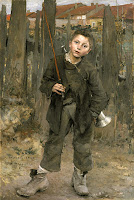쥘 바스티앵 르파주 (Jules Bastien-Lepage)
프랑스의 자연주의 화가
Portrait of Sarah Bernhardt (1844-1923), 1879
All Souls' Day, 1878, oil on canvas, 46 × 55 cm
Diogenes, 1873, oil on canvas
La Communiante, 1875, oil on canvas, 53.02 × 37.78 cm
Ruhende Landleute, c. 1877, oil on canvas
Portrait of French philosopher Adolphe Franck (1809-1893), 1878
The Annunciation to the Shepherds, 1875, oil on canvas, 147.9 x 115.2 cm
Achilles and Priam, 1876
Hay making, 1877, oil on canvas, 160 x 195 cm
October, 1878, oil on canvas, 180.7 x 196 cm
Joan of Arc, 1879
Young Girl, 1881
Pauvre Fauvette, 1881
Marie Samary of the Odéon Theater, c. 1881
Ophelia, 1881
Pas Mèche (Nothing Doing), 1882, oil on canvas, 132.1 x 89.5 cm
Going to School, 1882
L'Amour au Village, 1882
Jules Bastien-Lepage
“And when other painters saw Bastien-Lepage´s pictures and discovered he had simply set up his easel outdoors, posed his models, and painted right there through to the finish, they sought to do likewise with an unprecedented fervor. All this activity resulted in a fresher, more vivid concept of outdoor color and by the year 1880 the plein-air movement was in full swing.” - Anthony Watkins

Equally so, the invention of the foldable paint tube in the 1840s was a technological breakthrough that made paintings outdoors easy. Before he set up his easel in the open air, few painters had ventured outside as Jules Bastien-Lepage (1848-1884) did. A realist, like the much better known Jean-Francois Millet, Bastien-Lepage distinguished himself by the particularity he brought out in his subjects.

They stand before us, near the frame of his paintings, almost ready to walk out of the background where they stand. Bastien-Lepage painted from a standing position to maintain the integrity of the relationship of the figures to their surroundings. His grasp of aerial perspective was much criticized but he defended it vehemently.

In many of his paintings the figure fills the canvas; the landscape around the figure is defined by the size of the brushstrokes the artist used to depict it. He used detailed marks for the grasses or stones in the foreground; broader, boxy strokes for the middle distance; and a series of softer, less definite strokes suggest the far distance. Perspective is merely indicated, but notice the care Bastien-Lepage took in selecting titles for his paintings. The location and date of Roadside Flowers in Damvillers is inscribed in the lower left corner, even as the care-weary child dominates the picture.

Bastien-Lepage grew up on a farm in rural eastern France, far from Paris. Although his parents encouraged him to draw, they could not imagine a career in art for their son. So Jules went to work as a postal clerk and studied art at night. This context helps in looking at Going To School (at left), a work that might strike us as sentimental unless we remember that for rural children in the 19th century to attend school was often a financial sacrifice for the family that depended on the labors of all its members..

While serving as a sharpshooter in the franco-Prussian War of 1870, Bastien-Lepage received a severe chest wound which may have contributed to his early death. Having got himself to Paris, Jules tried ,with little success, to get work as an illustrator. That came in 1874 when he showed Portrait of My Grandfather and again in 1877, when his Hayfield captivated the annual Salon.

The day after his death in his Paris studio on December 10, 1884, Jules Bastien-Lepage was buried in the family's cemetery in Damvillers. The memorial exhibition at the Musee d'Orsay in 1885 sold out and his work was kept alive by the discerning critic Roger Marx, who arranged a show of Bastien-Lepage's work at the Paris International Exposition of 1900.
The man, the artist, believed that everyone has a place in nature. This is the connection between a figure like the woodcutter from Damvillers, whom he knew, and his Joan of Arc, a vividly imagined woman of the woods . Both belong to a world that is encompassed by the phrase, coined by M.H. Abrams: 'natural supernaturalism.'


Images:
1. Portrait of the Artist's Mother, 1877, Musee des Beaux-arts, Nice.
2. Portrait of My Grandfather, 1869, Musee des Beax-Arts, Nice.
3. October Season - Picking Potatoes, 1879, National Gallery of Australia, Melbourne.
4. The Woodcutter - Pere Jacques, 1881, Milwaukee Art Museum.
5. Going to School, 1884, Aberdeen Art Gallery, Scotland.
6. Marchande des fleurs a Londre (Flower Seller in London, 1882, via Artmagick.
7. Pas de mache (Nothing Going, 1882, National Gallery of Scotland, Edinburgh.
8. Joan of Arc, 1878, Metropolitan Museum of Art, NYC.
9. Roadside Flowers in Damvillers a/k/a The Little Shepherdess, 1882, private collection, France.
쥘 바스티앵 르파주 (Jules Bastien-Lepage, 1848~1884)
Self-portrait
프랑스의 화가. 당비레 출생. 주로 전원풍경이나 농민생활을 소박하게 그렸으며, 초상화와 풍속화에도 뛰어났다.
일찍이 카바넬의 제자가 되어 전통적인 프랑스회화의 기법을 익히고 쿠르베와 마네의 영향도 받았으나, 나중에는 모네 등의 인상주의의 특징인 외광(外光) 묘사도 받아들였다. 그러나 심정적(心情的)으로는 밀레에 가장 가까웠다.
대표작에 《목초밭》《사라 베르나르상(像) Portrait of Sarah Bernhardt》 등이 있다.
'문화 역사 시사 > 문화 자료' 카테고리의 다른 글
| 창원(菖園) 노숙자(盧淑子, 1943~ ) 한국화 (0) | 2017.05.25 |
|---|---|
| Prophecy Song - Joanne Shenandoah (0) | 2017.05.02 |
| 가수 박기영 (0) | 2017.03.16 |
| 스미스소니언사진展 (0) | 2017.02.07 |
| 화가 Pino Daeni의 작품세계 (0) | 2017.02.07 |



















